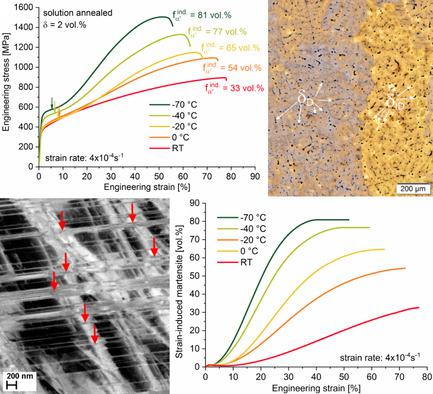当前位置:
X-MOL 学术
›
Steel Res. Int.
›
论文详情
Our official English website, www.x-mol.net, welcomes your
feedback! (Note: you will need to create a separate account there.)
Strain-Induced Martensite Formation and Mechanical Properties of Fe–19Cr–4Ni–3Mn–0.15N–0.15C Austenitic Stainless Steel at Cryogenic Temperature
Steel Research International ( IF 1.9 ) Pub Date : 2021-01-26 , DOI: 10.1002/srin.202000611 Saba Alsultan 1 , Caroline Quitzke 1 , Zhaoyang Cheng 2 , Lutz Krüger 3 , Olena Volkova 1 , Marco Wendler 1
Steel Research International ( IF 1.9 ) Pub Date : 2021-01-26 , DOI: 10.1002/srin.202000611 Saba Alsultan 1 , Caroline Quitzke 1 , Zhaoyang Cheng 2 , Lutz Krüger 3 , Olena Volkova 1 , Marco Wendler 1
Affiliation

|
Herein, considerable insight is provided into the evolution of strain-induced martensite and mechanical properties of Fe–19Cr–4Ni–3Mn–0.15N–0.15C wt% austenitic stainless steel (in short Cr19NC15.15) during deformation at room temperature and cryogenic temperatures. In situ magnetic measurements of the martensite evolution during tensile tests at various temperatures are conducted. The triggering stress required for strain-induced martensite formation is determined at the minimum in the strain hardening curve. It is found that with reducing deformation temperature in the range from 0 to –20 °C slightly decreases, whereas the triggering stress increases with further reduction of deformation temperature to −70 °C. The relation between the formed α′-martensite fraction and the strain applied during tensile test is established. The results demonstrate that a reduced deformation temperature from room temperature (RT) to −70 °C significantly enhances the transformation rate and the total volume fraction of strain-induced α′-martensite. The yield and tensile strength increase whereas elongation continuously decreases due to an increasing α′-martensite volume fraction with decreasing tensile test temperature. The α′-martensite formation kinetic follows Olson and Cohen's model and are in good agreement between the in situ experiment and theoretical calculations.
中文翻译:

Fe-19Cr-4Ni-3Mn-0.15N-0.15C奥氏体不锈钢在低温下的应变诱导马氏体形成和力学性能
在此,对 Fe-19Cr-4Ni-3Mn-0.15N-0.15C wt% 奥氏体不锈钢(简称 Cr19NC15.15)在室温和低温变形过程中应变诱发马氏体和机械性能的演变提供了相当多的见解。温度。进行了在不同温度下拉伸试验期间马氏体演变的原位磁性测量。触发压力在应变硬化曲线的最小值处确定应变诱发马氏体形成所需的条件。结果表明,随着变形温度在 0 到 –20 °C 范围内的降低 略有下降,而触发压力 随着变形温度进一步降低到-70°C而增加。建立了形成的α'-马氏体分数与拉伸试验期间施加的应变之间的关系。结果表明,将变形温度从室温 (RT) 降低到 -70 °C,显着提高了应变诱导的 α'-马氏体的相变速率和总体积分数。由于随着拉伸试验温度的降低,α'-马氏体体积分数增加,屈服和拉伸强度增加,而延伸率不断降低。α'-马氏体形成动力学遵循 Olson 和 Cohen 模型,并且在原位实验和理论计算之间具有良好的一致性。
更新日期:2021-01-26
中文翻译:

Fe-19Cr-4Ni-3Mn-0.15N-0.15C奥氏体不锈钢在低温下的应变诱导马氏体形成和力学性能
在此,对 Fe-19Cr-4Ni-3Mn-0.15N-0.15C wt% 奥氏体不锈钢(简称 Cr19NC15.15)在室温和低温变形过程中应变诱发马氏体和机械性能的演变提供了相当多的见解。温度。进行了在不同温度下拉伸试验期间马氏体演变的原位磁性测量。触发压力在应变硬化曲线的最小值处确定应变诱发马氏体形成所需的条件。结果表明,随着变形温度在 0 到 –20 °C 范围内的降低 略有下降,而触发压力 随着变形温度进一步降低到-70°C而增加。建立了形成的α'-马氏体分数与拉伸试验期间施加的应变之间的关系。结果表明,将变形温度从室温 (RT) 降低到 -70 °C,显着提高了应变诱导的 α'-马氏体的相变速率和总体积分数。由于随着拉伸试验温度的降低,α'-马氏体体积分数增加,屈服和拉伸强度增加,而延伸率不断降低。α'-马氏体形成动力学遵循 Olson 和 Cohen 模型,并且在原位实验和理论计算之间具有良好的一致性。











































 京公网安备 11010802027423号
京公网安备 11010802027423号